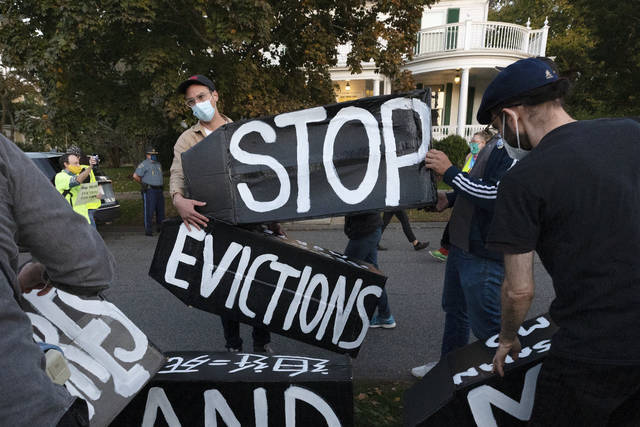
COLUMBUS, Ohio (AP) — A federal freeze on most evictions enacted last year is scheduled to expire July 31, after the Biden administration extended the date by a month.
The moratorium, put in place by the Centers for Disease Control and Prevention in September, was the only tool keeping millions of tenants in their homes. Many of them lost jobs during the coronavirus pandemic and had fallen months behind on their rent.
Landlords successfully challenged the order in court, arguing they also had bills to pay. They pointed out that tenants could access more than $45 billion in federal money set aside to help pay rents and related expenses.
Advocates for tenants say the distribution of the money has been slow and that more time is needed to distribute it and repay landlords. Without an extension, they feared a spike in evictions and lawsuits seeking to boot out tenants who are behind on their rents.
As of June 7, roughly 3.2 million people in the U.S. said they face eviction in the next two months, according to the U.S. Census Bureau’s Household Pulse Survey. The survey measures the social and economic effects of the coronavirus pandemic every two weeks through online responses from a representative sample of U.S. households.
Here’s the situation in Ohio:
WHAT’S THE STATUS OF EVICTION MORATORIUMS IN THE STATE?
The state of Ohio never enacted its own eviction moratorium and is following the federal moratorium. At the county and city level, some courts have taken the moratorium seriously, essentially following the letter of the order, said Marcus Roth, development director for the Coalition on Homelessness and Housing in Ohio. “Others are basically ignoring it, and there’s everything in between,” he said.
During a normal year, Ohio landlords file between 105,000 and 110,000 evictions, according to Ohio Supreme Court data. In 2020 they filed 69,000 evictions — only 36% fewer than 2019.
WHAT’S BEING DONE TO HELP PEOPLE FACING EVICTION?
In the fall of 2020, the state invested more than $111 million in CARES Act funding for emergency rental assistance, and created the Home Relief Grant program administered by local Community Action Agencies. Ohio received an additional $1.5 billion in emergency rental assistance dollars from the December federal relief bill and the American Rescue Plan in March, and in May the Legislature appropriated $465 million of that funding for rent relief and utility assistance, with more appropriations to come.
The extent of need has overwhelmed the agencies distributing the aid and there’s a concern that applicants might not receive rent assistance before the moratorium expires. “If that’s the case, then many renters could face housing insecurity,” said Alison Goebel, executive director of the Greater Ohio Policy Center.
Some communities, including Dayton and Lakewood in suburban Cleveland, passed local “pay to stay” laws which require landlords to accept rent if tenants come up with it before an eviction hearing.
HOW ARE THE COURTS HANDLING EVICTION HEARINGS?
Lawsuits challenging the federal moratorium have led to uncertainty about whether and where it needs to be enforced. Some Ohio judges still require renters to prove they made every effort to cover rent after pandemic-related job losses. Other judges grant the moratorium protection, while still others have taken to delaying cases to allow renters time to access the backed-up rental assistance money. Where the latter is concerned, the result is judges “just using their administrative decision-making processes to slow the process down to avoid unnecessary evictions,” said Graham Bowman, staff attorney with the Ohio Poverty Law Center.
WHAT IS THE AFFORDABILITY IN THE STATE’S MAJOR RENTAL MARKETS?
The Coalition on Homelessness and Housing in Ohio has determined that only 42 rental units are affordable and available for every 100 extremely low-income households in Ohio. The group also found that the hourly rate that renters must earn to afford a basic, two-bedroom apartment is $15.99, while only three out of the 10 most common jobs in Ohio actually paid employees more than that. The affordability ranges from city to city but is acute in state capital Columbus, where renters need to earn $19.02 an hour for a two-bedroom apartment. The average renter’s household wage statewide is $14.42 an hour.
Census data show that about 248,000 Ohioans are concerned they won’t be able to pay next month’s rent and about 112,000 Ohioans are concerned they will be evicted within the next two months.
ARE EVICTIONS EXPECTED TO CREATE A SURGE IN HOMELESSNESS?
A post-moratorium surge in homelessness is a big concern but not an immediate one for housing advocates. That’s because evicted renters typically move in with friends or family first as opposed to heading immediately for a shelter. But that could change down the road.
“If there is a real spike in evictions, eventually we’ll see a spike in homelessness as well,” Roth said.
Exacerbating the problem, renters with an eviction in their record have a much harder time finding an apartment for the same price — if at all — in the future.


